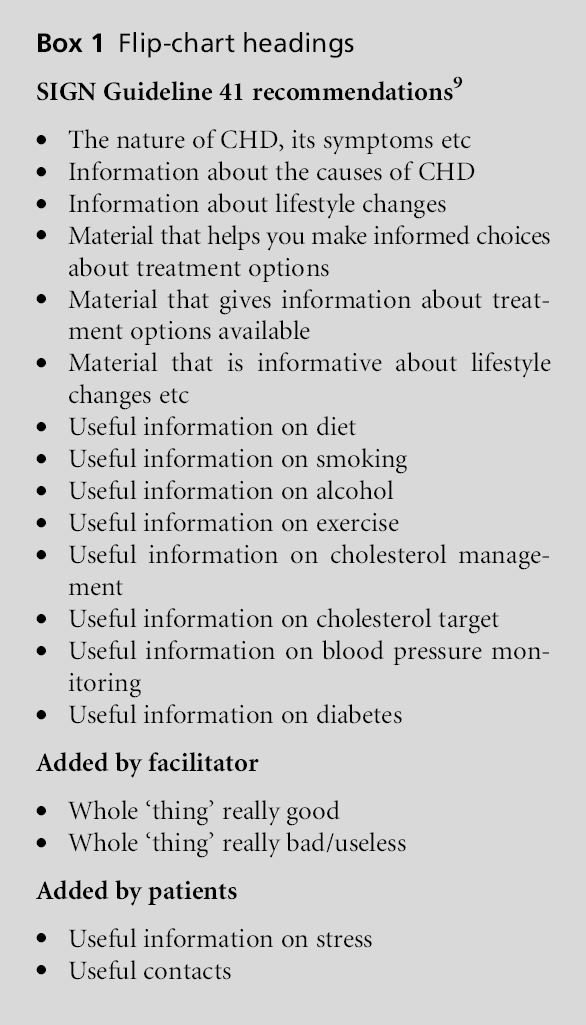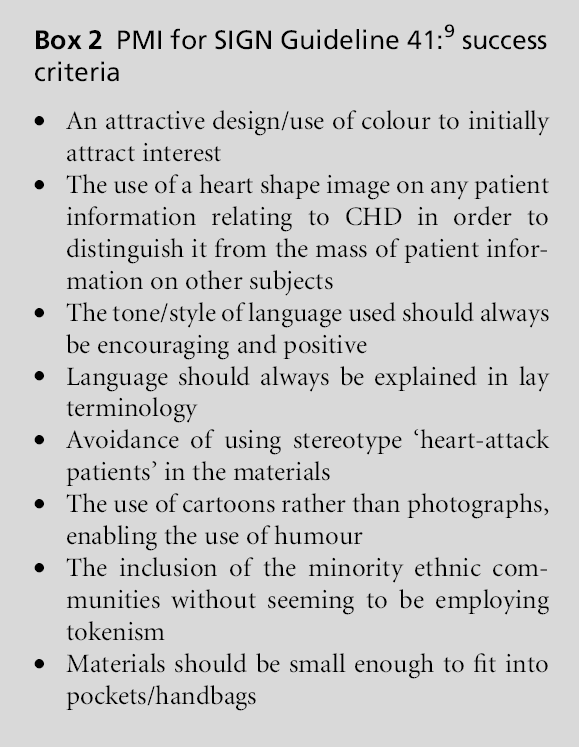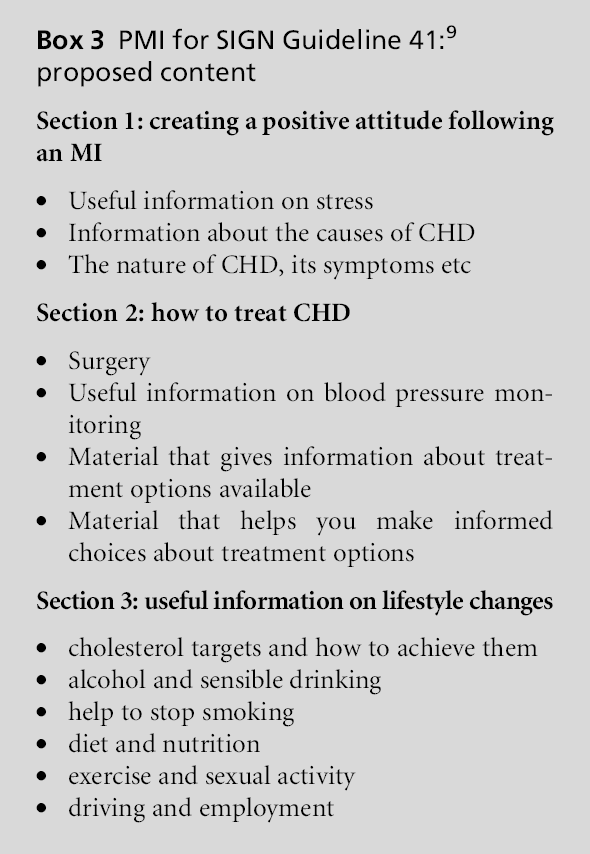Research Paper - (2006) Volume 14, Issue 2
SIGN Guideline CHD Prevention Subgroup 2006
Associate and Appraisal Advisor, NHS Education for Scotland (West), Glasgow, UK
Alan Ross BA MSc
Ross Consulting, Edinburgh, UK
Murray Lough MD FRCGP
Assistant Director NHS Education for Scotland (West), Glasgow, UK
Diane Rich
Secretariat Royal College of General Practitioners (Scotland), Edinburgh, UK
Received date: 1 November 2005; Accepted date: 10 March 2006
Aim To explore post-myocardial infarction (MI) patients’ perceptions of a patient-mediated intervention (PMI) for secondary prevention of coronary heart disease (Scottish Intercollegiate Guidelines Network (SIGN) Guideline 41), the extent to which their expectations are currently being met and a collective proposal for a newmodel. Method Qualitative study involving six post-MI patients who, in a workshop and focus group discussion:individually assessed 46 existing materials,collectively selected the most appropriate and relevant material, described the characteristics of an ‘ideal’ intervention and designed a newPMI for the implementation of SIGN Guideline 41.Results Of the 46 materials examined no intervention was considered ‘really good’. While none was ‘wholly irrelevant or bad’, patients identified a lack of information on targets and facts about cardiac surgery. While patients generally accepted cardiologists’ recommendations, there was uncertainty about ‘risk’ and a preference for material thathelped them make informed choices about treatment options. Patients reported that existing materials are introduced too early when they feel unable to assimilate information. They expressed a need for greater carer involvement early post-MI. Patients demonstrated the capacity to work within a framework defined by SIGN Guideline 41. A model for a graded, interactive intervention to provide and assess knowledge and support empowerment wasproposed. Rehabilitated patients demonstrated a willingness to adopt befriending roles. Conclusion This study suggests that existing interventions are not meeting the needs of post-MI patients. Efforts to develop, pilot and implement patient-mediated interventions to assist selfmanagement should continue.
coronary heart disease, decisionmaking, guidelines, patient preference, self-management, treatment choice
A survey commissioned by the Department of Health has provided evidence that communication with post MI patients and their carers is lacking.[1] Inadequate communication can lead to anxiety, dissatisfaction and poor compliance with treatment.[2]
Risk communication and howpatients perceive risk can influence their risk-taking behaviour. People are inclined to make overly optimistic judgements of personal risk.[3] This can have dire consequences after a myocardial infarction (MI), when smoking is a major risk factor for fatal and non-fatal recurrences.[4] In spite of a recognised need for a national evidence base for the effects of involving patients on the use of services, quality of care and satisfaction or health of patients, progress towards patient empowerment care remains under-researched.[5,6] More and better research to evaluate the effects of using patient-centred health information, in particular, is required in the UK.[7]
The ‘Expert Patient Programme’ advocates five core skills for self-management of chronic disease: problem solving, decision making, resource utilisation, formation of a patient–professional partnership and taking action.[8] The aim of this work was to explore patients’ views and opinions of what constituted a relevant and acceptable intervention, which would assist their involvement in problem solving and decision making following an MI. The basis for discussion was the Scottish Intercollegiate Guidelines Network (SIGN) Guideline 41, Secondary Prevention of Coronary Heart Disease following Myocardial Infarction.[9] The end result would be a template for a ‘patient-mediated intervention’ (PMI) for post-MI patients.
Over eight weeks, 99 interventions (leaflets, manuals, information packs and videos etc) were collected by the project team of the Royal College of General Practitioners (RCGP) (Scotland), of which 46 interventions fulfilled the criteria:
. they were relevant to one or more of the recommendations in SIGN Guideline 41[9]
Six post-MI patients, selected geographically in five faculty regions of Scotland, participated in the exercise on 5 December 2002, facilitated by an independent researcher. There were four components to the study.
Workshops
Workshop 1: individual assessment of 46 existing materials
In the morning session, patient participants individually studied the 46 interventions, which fulfilled the selection criteria, documenting, where possible, their initial impressions.
Workshop 2: group selection of materials considered appropriate and relevant
Sheets of flip-chart paper were placed on the walls around the room. Fourteen sheets were each entitled by one of the recommendations of SIGN Guideline 41 and two were named ‘whole thing really bad’ or ‘whole thing really good’ (see Box 1). During this task the group asked for two extra flip chart pages to be added to those already around the room which were given the heading, ‘Useful information on stress’ and ‘Useful contacts’.

The facilitator explained to the group that he wanted them to look at all of the materials and, working in pairs, to literally rip out the page(s) that contained the best/most appropriate information and highlighting, in pen, the relevant sections. These pages or the entire item were handed to either the facilitator or administrator who attached them to the appropriate flip-chart – as instructed by group members.
Focus group discussion
The same patients participated in an interactive discussion, which was audio-recorded and transcribed for analysis using a framework method of qualitative data analysis.[10] Specific parameters for discussion were the recommendations of SIGN Guideline 41, and the context was the patient’s pathway through the health services from diagnosis, investigation and treatment, aftercare and rehabilitation. Key themes included process and structural factors.
Plenary: a new model of PMI for the implementation of SIGN Guideline 41
Using the methodology described, the above participants then focused on describing what they considered to be an ‘ideal’ model of a PMI for the implementation of SIGN Guideline 41. The flip-charts formed the basis of the content of the proposed PMI.
Feedback: validation
A final draft of the paper was sent to all participants for validation of the content. Changes were made where appropriate.
There were six post-MI patients (five men, one woman) of age range 45 to 68 years, younger than normal for coronary heart disease (CHD). Two patients had undergone a coronary artery bypass graft (CABG) and one was on a waiting list for the procedure.
Workshops
Workshop 1: individual assessment of 46 existing materials
The group undertook assessment of 46 existing interventions.
Workshop 2: group selection of materials considered appropriate and relevant
Participants discussed the extent to which existing interventions selected had met the recommendations of SIGN Guideline 41.[9] Five flip-charts remained blank –‘useful information on cholesterol target’, ‘surgery’, ‘material that helps you make informed choices about treatment options’, ‘whole thing irrelevant/ bad’, ‘whole thing good’. Thirteen flip-charts were presented to the focus group for discussion.
Focus group discussion
Key themes were as follows.
Process factors
THE NEED FOR AND RIGHT TO INFORMATION
‘I don’t think that anyone who has a serious heart condition should have to go and look for information. It should be treated the same as medicine that is essential for you. You need to get hold of information and understand exactly what has happened to you.’
Participants also felt that the needs of patients’ carers and families were often overlooked when the focus of attention was the patient.
‘They don’t really understand what’s happened. They’re stuck, suspended with you lying there, they’re helpless.’
‘Patients can be very self-centred and selfish.’
TIMING OF INFORMATION
A recurring theme that emerged from discussion was the emotional impact of this life event, the gravity of which patients felt was underestimated by health professionals, who provided excessive and inappropriate information. Some information, they felt was introduced too early in hospital, in particular that relating to sexual intercourse and exercise.
‘It was overpowering.’
‘I had information that was going to help in 12 weeks’ time ... and I’m just lying there thinking I’m going to have another heart attack.’
‘Information needs progress ‘‘step by step’’.’
TARGET SETTING
Patients valued personalised targets and treatment plans.
‘We need specifics for smoking, alcohol limits.’
‘There’s a lot on cholesterol but not on cholesterol target.’
‘It’s not properly explained.’
INVOLVEMENT IN DECISIONS ABOUT TREATMENT OPTIONS
Patients felt that active participation in shared decision making about treatment options was limited to lifestyle change.
‘[We] may not actually physically have a choice.’
There was a risk that they might make the wrong decision.
‘I had a heart attack and the [general practitioner] GP asked if I wanted to be treated at home or put into hospital. Is that what they mean by choice? I obviously made the wrong choice. I said I would be treated at home. Had I gone into hospital, things would have been done quicker. Like my exercise test it took six weeks.’
When it came to cardiac surgery, shared decision making was considered wholly inappropriate.
‘Don’t have the option. It’s done or you die.’
‘Absolutely. It’s a bypass or it’s not a bypass.’
‘I was given three books, one was on angiograms, one was angioplasty and another on bypass surgery. They didn’t help me make an informed choice. Informed choice suggests we have a choice. We don’t [banging the table] have a choice.’
EMPOWERMENT
The group felt strongly that patients should take responsibility for their own health and, in their experience, existing materials failed to promote empowerment. Patients described the need for information, which transferred the locus of control from ‘what you can do for me’ to ‘what I can do for myself ’.
The group agreed that empowerment could not be achieved through the provision of information alone.
‘Absolutely nothing written down on paper will empower you to make lifestyle changes. It’s the fright of the heart attack or bypass.’
The group was aware of the emergence of maladaptive behaviours, which undermine empowerment.
‘It’s when you go home and your wife tells you it’s time you painted the windows. And you say hang on a minute, three months ago I had a heart attack and you were treating me like an invalid.’
The group acknowledged that there were those who ‘did not want to take responsibility for themselves’.
‘Long-term exercise and lifestyle change is more of a problem than any of them.’
RISK ASSESSMENT
Patients’ understanding and perception of the risks associated with CABG surgery varied and was related to the way in which risk was communicated.
‘I read up on the information, which said that the death rate was 2%. I didn’t take it at face value.’
‘Yes 2%. That was quite heartening for me.’
‘The surgeon said that the op was 95% successful. It made me quite suspicious because it was such a high figure.’
Structural factors
Post-MI patients’ descriptions of the characteristics of a successful PMI for the secondary prevention of CHD are summarised in Box 2.

PRESENTATION AND FORMAT
Important features included ‘visual appeal’ and immediate relevance through the use of colour, diagrams and an image ‘which relates to yourself ’. ‘Pocket-sized’ material ‘small enough to pick up and carry away’ was suggested.
There was heated debate about the relative merits of different media for conveying information.
‘What makes you think the information will be up to date at the end of the decade? It needs to be electronic. Most people have a CD/DVD/computer.’
‘But people who don’t have computers are likely to be most in need [of information].’
LANGUAGE AND TONE
The group was unanimous in identifying ‘a positive attitude’ or ‘sense of the future’ as a key step to recovery. Patients appreciated unambiguous information addressing ‘why me’, ‘the why, when and what of CHD’ and ‘what should I be doing’ during the inpatient stage and early post-discharge period.
Patients resented being given ‘stereotypical information’ and not being treated as individuals with unique experiences.
‘It is important that people are aware that there are many different roads to a heart attack.’
Plenary: a new model of PMI for the implementation of SIGN Guideline 41
While continuing their discussion, patients sorted the 13 flip-charts into three sections. They described a series of three booklets (see Box 3) containing information in the following sequence which, from their personal experience, corresponded to the needs and capacity of patients to assimilate information post- MI.

Appropriate interventions would be issued at certain points along what they called a ‘progress line’. The group referred to a ‘progress line’ in preference to a standard ‘time-line’ because they thought different patients would progress at different rates (especially when taking the age of the patient into account).
The first booklet would be made available in hospital on discharge fromthe coronary care unit (CCU), and would be returned to the surgery and exchanged for the next one in the series, almost like a library. The group was concerned about the amount of resources used to produce patient publications, and thought that this would be a useful way to reduce costs with the added bonus of giving the patient a sense of progressing in their treatment each time they returned a booklet.
It was also suggested that each booklet would contain a voluntary self-completed questionnaire, in which the patient themselves would rank on a scale from 1–10 their understanding of the issues raised. This questionnaire would be returned to a health professional who could provide the information that the patient felt they lacked, either by providing more specific information in written format, or face-to-face depending on the patient’s preference.
Patients in advanced phases of rehabilitation were to be encouraged to document their own risk factors, their management and feedback on, for example, adverse effects of medication in a shared-care card. At the end of the series, participants considered the ‘graduate’ in an expert role with the capacity to befriend newly diagnosed patients.
A separate booklet would be available for carers/ partners/family members when the first booklet was issued to the patient in hospital. A CD/DVD was perceived as a useful adjunct for ‘family’ to watch together with the patient, because it would spark discussion points.
As experienced consumers of health care, post-MI patients understand that they have the right to appropriate and relevant information. Following participation in a one-day workshop and focus group discussion, patients have contributed to the design of a PMI for the secondary prevention of CHD. Strengths include unanimity of viewpoints and patients’ capacity to work within a framework defined by SIGN Guideline 41.[9]
However, the focus group is not based on a large sample of people, neither is this sample representative in terms of educational attainment, social class or age. Socio-economic factors influence patients’ understanding of risk, perception of self-efficacy and adoption of healthy lifestyles. Older patients may express alternative preferences for risk factor modification and treatment.[11]
The 46 PMIs consisted of a purposeful sample of leaflets, manuals, information packs and videos selected by the RCGP (Scotland) from around 100 interventions collected in an (unpublished) exploratory study of materials being used in cardiac rehabilitation and community programmes around Scotland, in 2002.
While this number may seem excessive, it is small compared to the amount of available information, which is invariably unevaluated, particularly on the internet.
There is an apparent dichotomy between wanting more information about treatment options before making informed choices and preferring doctors to make the final decision. This is understandable given the complexity and urgency of intensive care and cardiac surgery, the probability, severity and timing of an adverse event, and the variation in patients’ understanding of and attitudes to risk.[12]
Other post-MI patients and those close to them can have greater insight into post-MI patients’ emotional needs than health professionals.[13,14] Carers and families, particularly spouses, play a crucial role in improving emotional and cognitive readjustment, self-esteem and commitment to risk reduction behaviours.[15]
The greater status attributed to blood pressure measurement (section 2, see Box 3) may reflect a perceived greater emphasis on the management of hypertension compared to smoking cessation or treating cholesterol ‘to target’ (section 3, see Box 3) in 2002. While smoking cessation has achieved greater prominence in 2006, blood pressure lowering is associated with reductions in CHD, stroke, heart failure, cardiovascular and total mortality.16 Acknowledging the coexistence of combined cardiovascular endpoints, the successor to SIGN Guideline 41, published in 2006, has been named Risk Estimation and the Prevention of Cardiovascular Disease.[17]
This research advances the understanding of the patient experience after an MI and the relevance of professionals’ interactions and interventions. An appropriate PMI for the secondary prevention of CHD has the potential to improve the patient experience of surviving an MI, self-management and clinical outcomes of health care.
Guidelines vary enormously in terms of context, content and complexity, precluding the development of a generic patient-mediated tool. However, if effective, this model could be applied to other areas of chronic disease management such as diabetes, asthma and epilepsy. Efforts to devise, pilot and implement patient-mediated interventions should be continued.
We thank the patients who participated in the study and the Royal College of General Practitioners (RCGP) (Scotland) for assisting with the research and Jane Hopton, Vikki Entwistle and Gerrie Campbell for methodological advice.
Jill Murie was formerly Director of Guideline Implementation RCGP (Scotland) 2002–2003.
None.